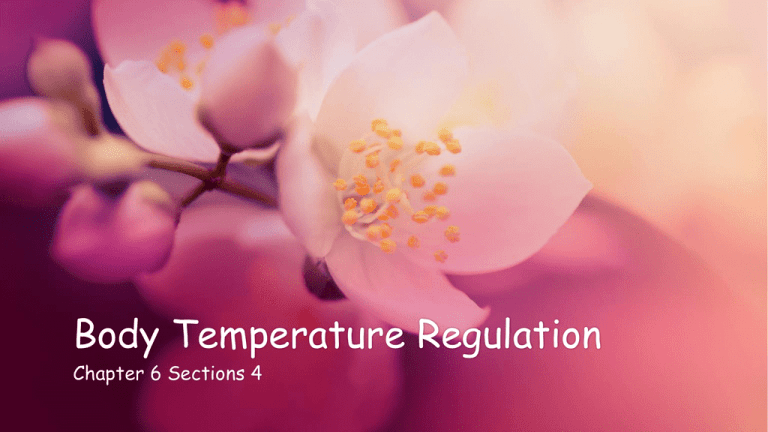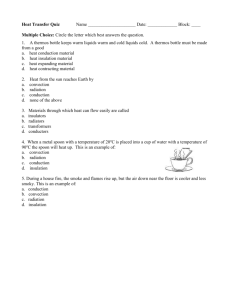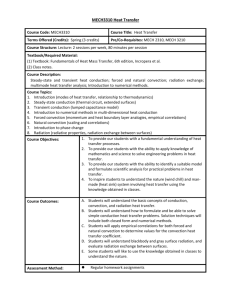What is Normal Body Temperature?
advertisement

Body Temperature Regulation Chapter 6 Sections 4 Objectives • Explain how the skin helps to regulate body temperature • Describe wound healing • Distinguish among the types of burns, including a description of healing with each type What is Normal Body Temperature? • Most people think of a "normal" body temperature as an oral temperature of 98.6°F (37°C). • This is an average of normal body temperatures. • Your temperature may actually be 1°F (0.6°C) or more above or below 98.6°F (37°C). • Also, your normal body temperature changes by as much as 1°F (0.6°C) throughout the day, depending on how active you are and the time of day. • Body temperature is very sensitive to hormone levels and may be higher or lower when a woman is ovulating or having her menstrual period Regulation of Body Temperature • Is vitally important to maintain metabolic functions • Even a slight temperature shift can slow down or speed up metabolic reactions • The deeper body parts remain close to a set point of 37°C or 98.6°F • The maintenance of a stable temperature requires that the amount of heat the body loses be balanced by the amount it produces • The skin is responsible for maintaining the balance Heat Production • Heat is a product of cellular metabolism • The major heat producers are skeletal muscle, cardiac muscle and liver cells • When body temperature rises above the set point, the nervous system stimulates structures in the skin and other organs to release heat An Example • During physical activity active muscle release heat, which the blood carries away • The warmed blood reaches the hypothalamus of the brain, which controls the set point of body temperature • The hypothalamus signals muscles in the walls of dermal blood vessels to relax • As these vessels dilate (vasodilation), more blood enters them, and some of the heat the blood carries escapes to the outside • At the same time, the deeper blood vessels contract (vasoconstriction), diverting blood to the surface and the skin reddens • The heart is stimulates to beat faster, moving more blood out the deeper regions Heat Loss--Radiation • The primary means of body heat loss is radiation, by which infrared hear rays escape from warmer surfaces to cooler surroundings • These rays radiate in all directions Heat Loss—Conduction & Convection • Conduction and convection release less heat than does radiation • In conduction, heat moves from the body directly into the molecules of cooler objects in contact with its surface • For example, heat is lost by conduction into the seat of a chair when a person sits down • In convection, continuous circulation of air over a warm surface causes the air to become heated as it moves away from the body Heat Loss--Evaporation • When the body temperature rises above normal, the nervous system stimulate eccrine sweat glands to release sweat onto the surface of the skin • As this fluid evaporates (changes from a liquid to a gas), it carries heat away from the surface, cooling the skin Heat Loss Summary Body Temperature Drops • When the body temperature drops below the set point, muscles in the walls of dermal blood vessels are stimulated to contract • This action does the following: • Decreases the flow of heat-carrying blood through the skin • Cause the skin to lose color • Helps to reduce heat loss by radiation, conduction and convection • sweat glands remain inactive, decreasing heat loss by evaporation • If the body temperature continues to drop, the nervous system will stimulate skeletal muscle cells throughout your body to contract slightly, increasing cellular respiration and production of heat • If this response is not enough to raise the body temperature back to normal, small groups of muscles rhythmically contact with greater force, causing you to shiver Process of Body Temperature Regulation Problems in Temperature Regulation • Sometimes the temperature-regulating mechanism does not work effectively • Such as on hot humid days when the air becomes saturated with water vapor • When this happens, sweat glands may be activated, but the sweat cannot quickly evaporate • Thus, you are wet but still hot and uncomfortable • In addition, if the air temperature is too high heat loss by radiation is less effective and a person can gain heat from the surroundings • Two dangerous situations can occur when temperature regulation fails: • Hyperthermia • Hypothermia Hyperthermia • Occurs when the core body temperature exceeds 106°F • The skin becomes dry, hot and flushed • The person can experience feelings of weakness, become dizzy and nauseous, have a headache, and a rapid, irregular pulse Hypothermia • Better known as lowered body temperature • Results from prolonged exposure to cold or as part of an illness • It begins with shivering and a feeling of coldness • If not treated, it progresses to mental confusion, lethargy, loss of reflexes, loss of consciousness, and eventually the complete shutdown of your vital organs • Even if your body’s core temperature drops only a few degrees, fatal respiratory failure or heart arrhythmia • Your extremities can withstand drops of 20°F to 30°F below normal • Some people are more prone to this because of less adipose tissue beneath the skin, advance age, too thin, and the homeless
![Applied Heat Transfer [Opens in New Window]](http://s3.studylib.net/store/data/008526779_1-b12564ed87263f3384d65f395321d919-300x300.png)


